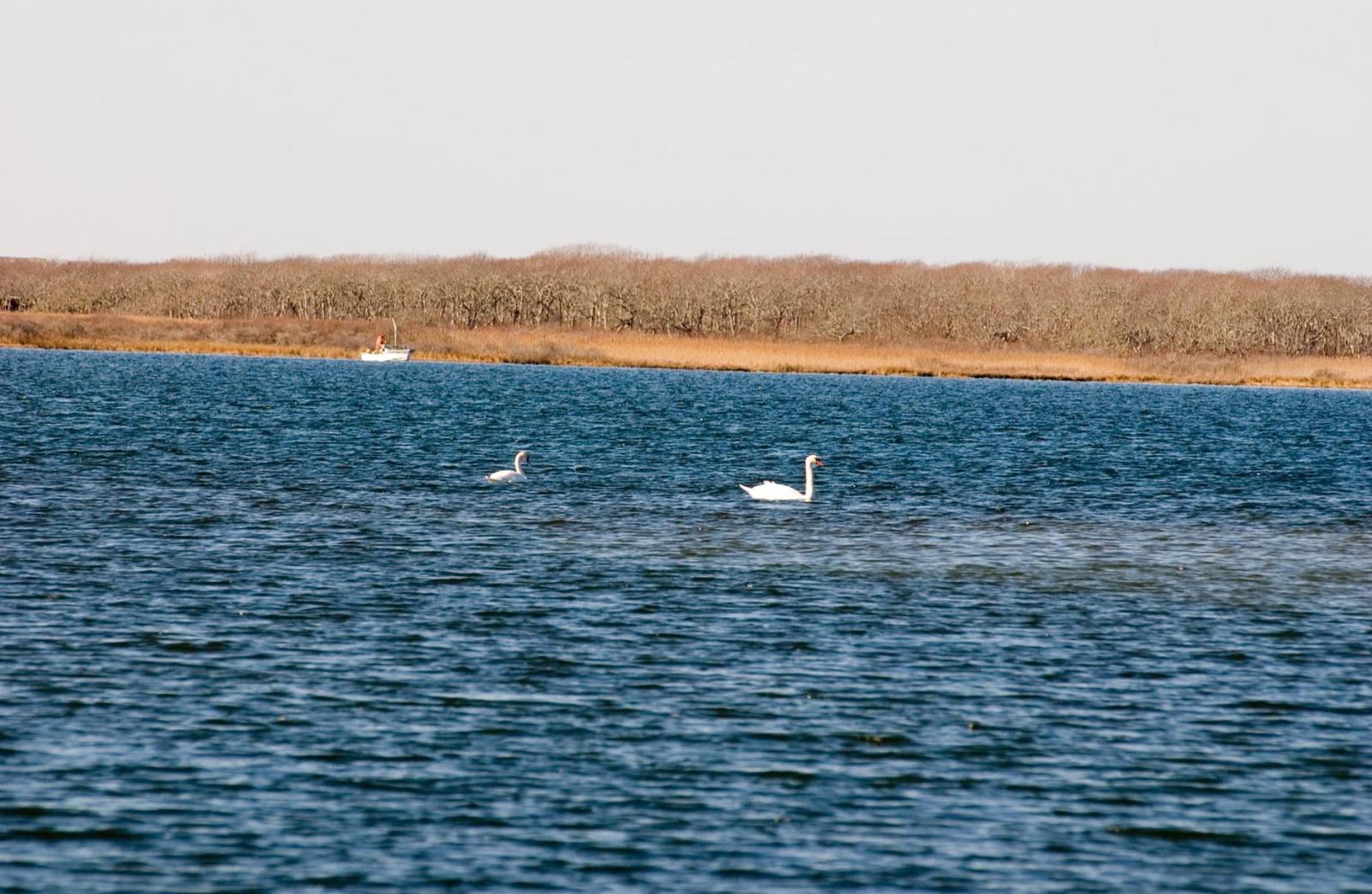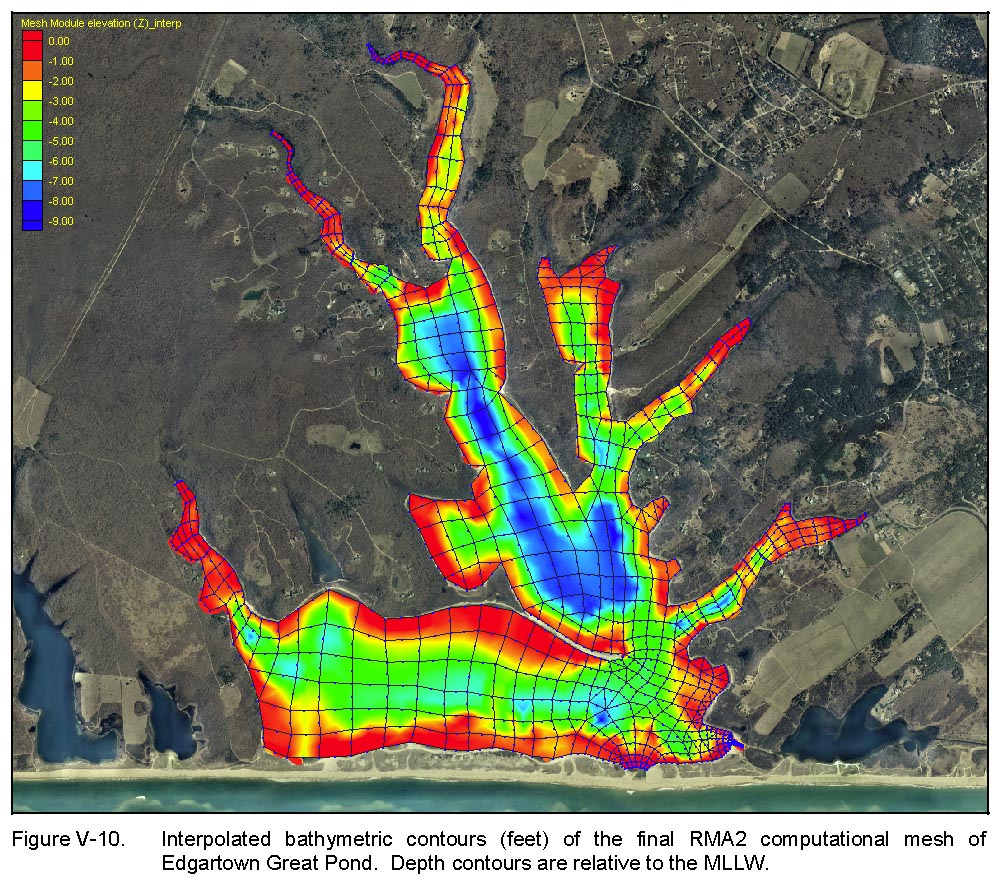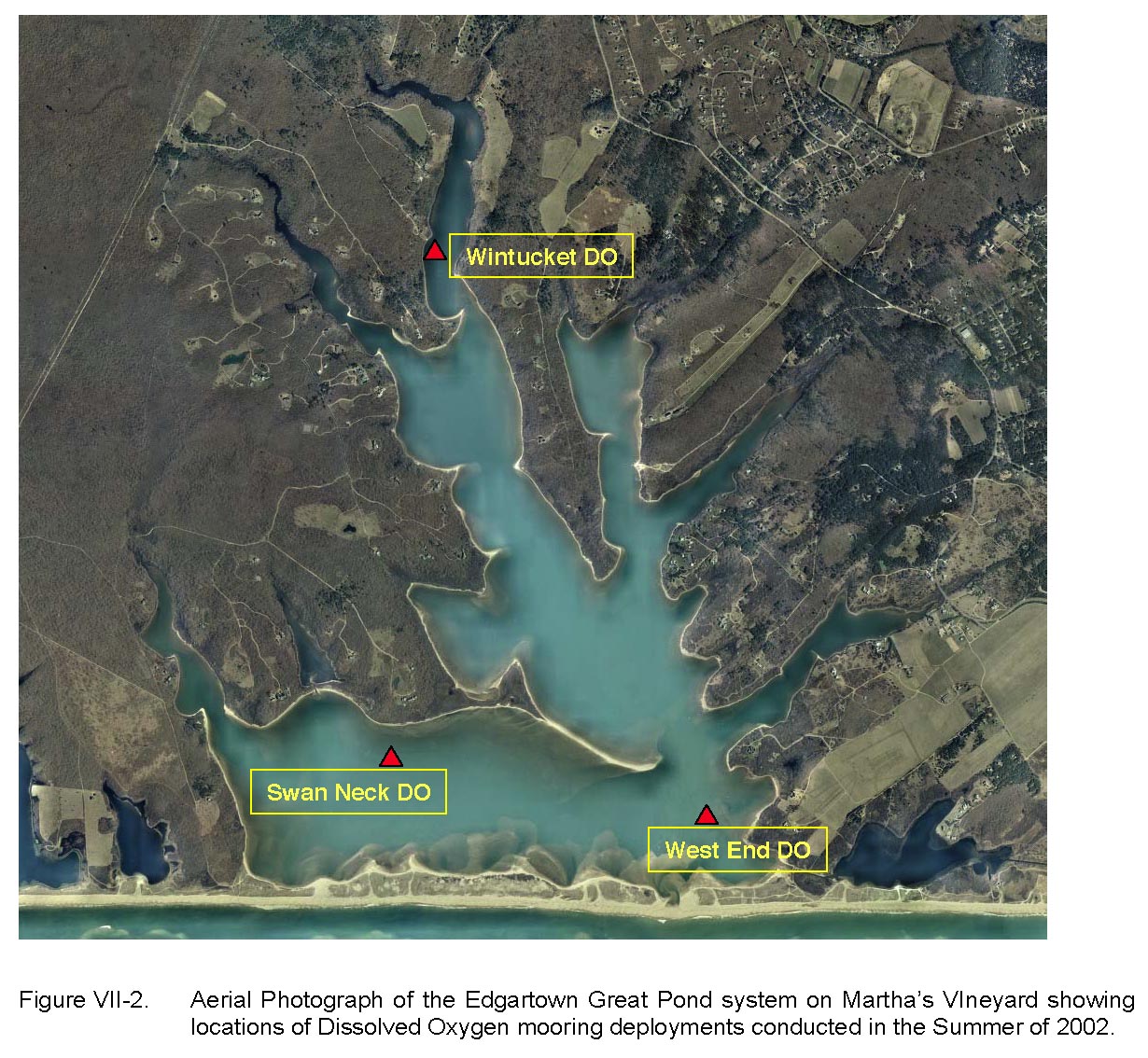If the Edgartown Great Pond is to be restored to environmental health, town authorities must find a way to cut nitrogen pollution coming from household septic systems by at least 30 per cent, according to a comprehensive scientific study of the pond’s water quality.
A draft report of the Massachusetts Estuaries Project finds that water quality in the Great Pond is significantly affected by heavy nitrogen loading, and that the biggest single contributor — responsible for more than 5,500 kilograms or one-third of total nitrogen entering the 890-acre pond each year — is household septic systems.
The draft report has not yet been publicly released but was obtained by the Gazette.
Led by a team of marine scientists at the University of Massachusetts at Dartmouth, the estuaries project has been under way for four years and involves a sophisticated, state-of-the-art study of coastal ponds and embayments throughout southeastern Massachusetts.
Several other ponds on the Vineyard are in the study, including Sengekontacket. The work, which is the first of its kind, included extensive sampling and subsequent computer modeling to determine precisely the source of pollution and poor water quality in the ponds.
The Edgartown Great Pond was the first Vineyard pond to be included in the study, in part because a good deal of work had already been done by the town, the Martha’s Vineyard Commission and a private foundation funded by a group of riparian owners. The 103-page draft report credits this work as a key baseline.
The complete draft report is posted and available for downloading on the Gazette Web site (mvgazette.com).
Nitrogen enriches the water, effectively acting as a fertilizer which encourages the growth and decay of algae, which leads to reduced water clarity and depletion of oxygen, especially in bottom waters, and increased deposits of nitrogen-rich organic matter into the sediments. Other life in the pond is starved of light and oxygen.
The process is called eutrophication, and the study found the Great Pond at particular risk for this, in part because it is not opened often enough to the flushing waters of the Atlantic Ocean.
The high nutrient load in the pond has led to a dramatic loss of eel grass beds and serious impact on fish and shellfish habitat, the report finds.
Apart from calling for a cut in the amount of nitrogen going into the pond, the draft report also recommends more frequent opening of the pond to the sea, especially in summer, so excess nutrients might be flushed out.
“Unfortunately, almost all of the estuarine reaches within the Edgartown Great Pond system are near or beyond their ability to assimilate additional nutrients,” the study says.
“As existing and probable increasing levels of nutrients impact . . . water quality degradation will accelerate, with further harm to invaluable environmental resources of the town and the Island as a whole,” it also says.
While the report says it may be possible to restore the eel grass beds, which have declined more than 90 per cent since 1951, it warns: “As part of future restoration efforts, it is important to understand it may not be possible to turn each embayment into a pristine system.”
Instead, the aim is to prevent nitrogen levels from rising above 0.5 milligrams per liter of water in the summer months, when the problem is at its worst.
While the report does not explicitly advocate the connection of homes in the pond’s watershed to the town sewer, Brian Howes, the marine scientist who is the technical director of the Estuaries Project, certainly sees it as the practical solution.
“Shifting some homes from septic to sewer would be a very efficient way of dealing with the problem, because the [existing Edgartown wastewater] treatment plant is removing about 90 per cent of the nitrogen,” Mr. Howes said yesterday.
The good news is, even without extra homes being tied into it, the Edgartown treatment plant is expected over the next few years to make a big contribution to reducing the total nitrogen load in the pond.
The reason is a 1996 upgrade of the plant. Before that the plant put about 2,404 kilograms of nitrogen into the pond, through groundwater leaching every year. Now it produces only about 695 kilograms.
The trouble is the lag time of 10 or 12 years as a plume of highly nitrogen-polluted groundwater from the old treatment plant makes its way to the pond.
“Review of the available water quality data suggests that the results of the upgrade have not reached the pond, but should be arriving within the next year or two,” the report says.
“That’s a good thing, Mr. Howes said, “because it means the town has already done a major fraction of the restoration.”
The bad news is that future population growth in the pond’s 4,500-acre watershed would require even more extensive remediation.
Buildout projections in the report show the potential for an additional 1,050 homes around the Great Pond, plus another 21.7 acres of developable commercial land within the watershed. If those homes were built, nitrogen loading in the pond could rise dramatically, more then 40 per cent.
But while the problem of limiting nitrogen entering the pond looks complex and expensive, the plan for flushing it out of the pond is simple.
“They just need to manage the openings of the pond in a slightly different way. It’s really about timing,” Mr. Howes said.
The draft report calls for opening the pond to the sea at least one more time in summer.
The report includes color maps showing watersheds, tide gauge locations, sediment sample areas, historic locations of eel grass beds and shoreline changes over the years. It describes the geological history of the pond, termed a Great Salt Pond and formed by a receding glacier 18,000 years ago.
The Great Pond is unusual in two ways: it is closed to the sea by a barrier beach along the south shore, and it includes a number of long, finger-like coves, called sub-embayments in the report.
Water quality varies dramatically in the different coves, the report found.
Swan Neck has poorest habitat, with similar impairment in three tributary coves — Jane’s, Wintucket and Mashacket.
The best water quality was found in the lower main basin and Job’s Neck Cove. Turkeyland and Slough Cove were intermediate quality.
And while septic systems are the main culprit, the study also measured nitrogen coming from other sources. Lawn fertilizers contributed 659 kilograms per year; agriculture was responsible for 368 kilograms and impervious surfaces, such as roofs, roads and driveways added 1,157 kilograms.
The report has been reviewed by the state Department of Environmental Protection and sent to the town board of health and the commission for review and comment.
Mr. Howes said yesterday he did not know when the final report would be made public because it has been delayed by the DEP.
“We finished that report on the July 1 deadline. DEP just gave us their response to the report on Nov. 2,” he said, adding: “DEP is doing some stuff that we don’t really understand. Right now we don’t actually have a contract to finalize the report. This is causing some consternation on our part. We’re finished but we can’t release until they allow us to,” he said.
Mr. Howes suggested that the delay with DEP may be because the environmental solutions being proposed by the Estuaries Project did not always fit within the department’s regulatory framework.
“They’re trying to change the scope of the project as it moves into implementation. This has led to a lot of letters of support going in from major agencies and towns,” Mr. Howes said.
“The basic problem is we are putting forward new tools and solutions for communities to do nitrogen management that do not fit well into the existing regulatory framework, which is one of protection. We are promoting restoration.
“It’s causing them policy angst.”
But he said the promised round of meetings with the local community to explain and discuss the findings of the Great Pond report would eventually happen with or without the help of the department.
“We will go ahead, if we have to, on our own dime, with the public meetings,” he said.













Comments
Comment policy »